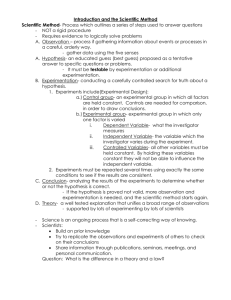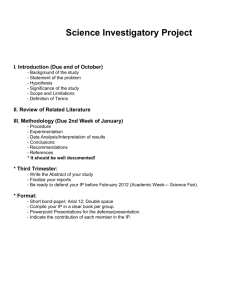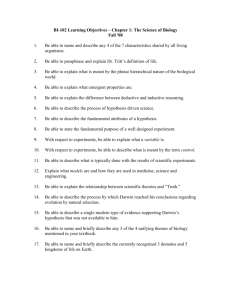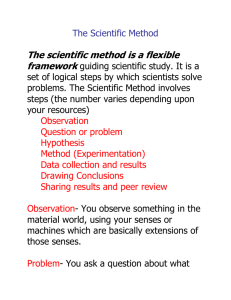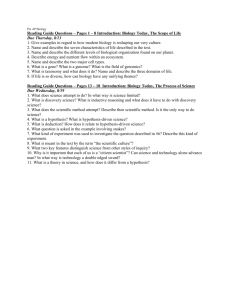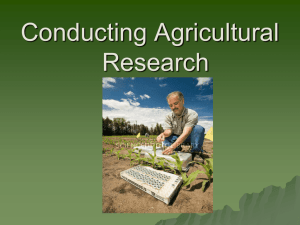Biology 1020 – Unit 1
advertisement
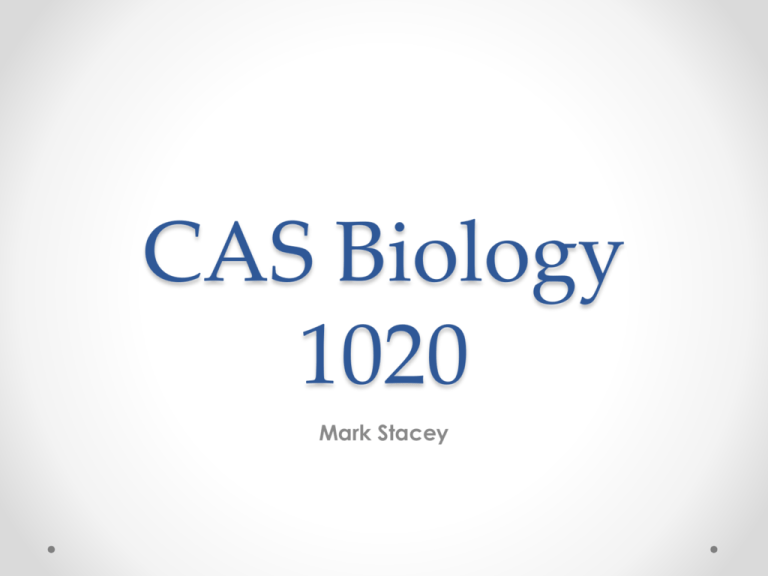
CAS Biology 1020 Mark Stacey Evaluation Tests – 30% Midterm – 15% Lab + Assignments – 15% Final Exam – 40% Unit 1 – Intro to Biology • Chapter 1 in text. • In this chapter, we will overview the biology from both a historical and scientific viewpoint. Science • What is science? • The word “science” derives from a Latin word meaning “knowledge”. • Science is a way to understand the world and how it works by using the Scientific Method. • The scientific method works by observing and recording results and then drawing conclusions that fit the data. By repeating this process, ideas are tested and modified/discarded as new evidence comes up. Biology • What is biology? • Biology is the scientific study of life. • There are many, many different ways to observe, understand and work with living things. Life • What is life? What distinguishes it from non-living things? • 1 – Homeostasis – the ability to maintain a steady internal state while the external environment changes. • 2 – Metabolism – the ability to perform chemical reactions to gain energy and to build new biological molecules Life • 3 – Energy Transformation – the ability to convert one form of energy to another • 4 – Growth/Development – the ability to increase the amount of biological material and thus increase in size and/or complexity. • 5 – Reproduction – the ability to produce offspring. All life as we know it is created from other life. Life • 6 – Evolutionary Adaptation – the ability to change the characteristics of oneself to respond to new environmental challenges. • 7 – Environmental Response – the ability to respond to stimuli in the environment. Viruses – Alive or Not? • Although both bacteria and viruses can make us sick in very similar ways, the two are VERY different. • Bacteria are simple living creatures. Each little cell can perform all of the life processes on it’s own. • Viruses, however cannot. A virus does not fulfill most of the properties of living things and so they are NOT considered to be living things. Viruses – Alive or Not? • Homeostasis – viruses have no mechanism to control their integral environment. When not infecting a host, they simply float around inert. • Metabolism – viruses only have the biological machinery to infect a host and replicate. • Energy Transformation – viruses do not take in “food” to obtain energy from. Viruses – Alive or Not? • Growth/Development – A virus does not grow. It simply makes copies of itself. • Reproduction – a virus requires a host cell to infect to reproduce. Without hijacking the machinery of a host cell, a virus cannot reproduce. • Response to environment – a virus does not change itself in any way outside of its infection cycle. Levels of Biology • Life can be studied at many levels: • • • • • • • • • • Biosphere Ecosystem Community Population Organism Organ System Organ Tissue Cell Sub-Cellular Structures Fields of Biology • Biologists can specialize into many different fields • • • • • • • • • • Cytology - cells Anatomy - structures Physiology – functions Ecology – interactions between species Zoology – animals Botany - plants Mycology - fungi Entomology - insects Taxonomy – lineages etc Researching Biology • There are two main methods used to gather knowledge in biology: • Discovery Science • The simplest and oldest form of biology; information if gathered by careful observation and comparing of data. • Hypothesis-Driven Science • More complex method where ideas (hypothesises) are tested in experiments by the scientific method. • Discovery Science will often tell you the basic answers while Hypothesis-Driven Science can tell you why and how things happen. Discovery or Hypothesis? • Galileo using a telescope to first see the moons of Jupiter. • The detection of the long-proposed Higgs Boson particle. • A group study to determine if a new drug will lower cholesterol levels. The Scientific Method • • • • • • • A Basic Framework of the Method: 1 - Determining a Question 2 - Forming a Hypothesis 3 – Conducting an Experiment 4 – Collecting Data 5 – Interpreting Data 6 – Drawing a Conclusion • 7 – Review/Repeat/Alternate Hypothesises Hypothesis vs. Theory vs. Law • While often used differently in everyday language, theory has a specific meaning within science. • A hypothesis is a proposed idea that scientists want to prove. Scientists carefully perform experiments and read the results to either prove/refine/disprove their hypothesis. Hypothesis vs. Theory vs. Law • A theory is a hypothesis that has been tested time and again and is supported by the observations of multiple experiments. • Thus, a theory is a model that can be used to explain current observations and also predict new ones. • Science keeps trying to prove theories wrong to make sure they are as accurate as possible. Hypothesis vs. Theory vs. Law • Laws are rules that describe how one thing in nature affects another. Many of these are mathematical formulas. Laws, like theories, are tested again and again to make them as accurate as possible. • Theory: gravity pulls people down towards the Earth • Law: F = m*g (the force exerted by gravity is proportional to the mass of the object) Experimentation • What makes up an experiment? What makes the results reliable? • Experiments search for cause and effect relationships. • To see if a certain factor causes another, very similar scenarios are created, with a slight difference between each to see what different inputs cause different outputs. Experimentation • These changing factors are called variables. • The independent variable is one that the scientist changes in each scenario. • The dependent variable is the changing results that arise from changing the independent variable. • By trying different situations, an experiment can create data to support or refute that the hypothesis that the independent variable causes the dependent variable to change. Experimentation • An experiment wants to see if different brands of soda harm teeth. Three teeth are placed in separate jars and a different soda added to each. These are left for 48 hours and then the teeth are inspected for decay. • The independent variable is the different types of soda. • The dependent variable is the level of tooth decay on the teeth. Experimentation • In an experiment, it is very important that we are sure that the independent variable is the only thing changing, so we are certain it is what is causing changes in the dependent variable. • As such, any other factor must be carefully kept consistent. These are controlled variables. • Similar to this is a control. This is one of the experiments done without the independent variable at all, to make sure the results do not happen on their own, or by some other factor. Experimentation • In the tooth decay experiment, controlled variables include: starting with teeth of similar quality, using the same amount of soda in each jar, using fresh soda for each brand, etc. This is done to prove the soda type caused the differences, and not other factors. • A control for this experiment would be another tooth placed in a jar without any soda added. This would serve to prove that teeth do not decay on their own, and any decay is caused by the soda only. Experimentation • What are the independent and dependent variables in each case? • How much water flows through a faucet when the tap is turned to different angles? • Does heating a cup of water allow it to dissolve more sugar? • Does fertilizer make a plant grow bigger? • Does an electric motor turn faster if you increase the voltage? Experimentation • When a factor other than the independent variable effects the dependent variable, it is called an extraneous variable. • Doing a control will often help you figure out how much these contribute to the result. • However, sometimes extraneous variables make results unreliable. Extra care must be taking in designing the experiment to avoid these factors. • Extraneous variables are very present in psychological experiments and in very complex systems. Experimentation • Extraneous variables are often time-related. Test one fertilizer in summer and another in winter isn’t a fair comparison as the weather conditions are very different. • In tests on people, mood/emotions are often extraneous. Doing a survey early in the morning may get different results from the same people than if the same people were asked in the afternoon. Experimentation • Discuss the potential extraneous variables: • EXAMPLE 1 • A researcher wanted to assess whether mood influenced people's memory. The researcher hypothesized that positive moods would lead to greater memory performance than would a negative mood state. On Monday the researcher had 50 subjects learn a list of nonsense syllables and then watch a very humorous comedy film. Their recall of the list of syllables was then assessed. On Tuesday the researcher had a second group of 50 subjects learn the same list of nonsense syllables and then watch an upsetting documentary on World War II. Their recall of the list was then assessed after having watched the film Experimentation • Discuss the potential extraneous variables: • EXAMPLE 2 • A researcher wanted to see whether a new way of teaching English was superior to a more traditional approach. The researcher selected two Thursday night classes at a local community college. In one class the instructor used a traditional method, the second instructor used the newer approach. The researcher then assessed students language ability after they had completed the program. Error • Nothing is perfectly accurate. Even very high-tech tools are not absolutely perfect. Therefore, all experiments have a certain amount of error. For example, the exact weight of a sample might not be known; it might only be measured to the nearest gram. • Human error is when a person makes a mistake during an experiment. This is avoidable and not counted in with the regular errors from other sources. Repeating experiments is a way to try to remove human error.
